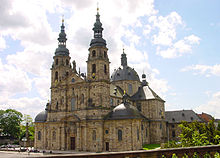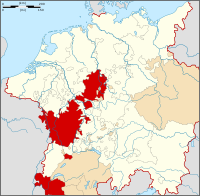- Fulda monastery
-
Imperial Abbey (Prince-Bishopric) of Fulda
Reichskloster (Fürstbistum) FuldaImperial Abbey of the Holy Roman Empire ← 
774–1802  →
→Coat of arms
Hessian territories about 1400, Fulda Abbey in violet Capital Fulda Government Theocracy Historical era Middle Ages
Early modern period- Founded 744 - Imperial immediacy 774 - Raised to
Prince-Abbacy1220 - Joined
Upper Rhenish Circle1500 - Elevated to
Prince-Bishopric1752 - Mediatised to
Nassau-Orange1802 - To Hesse-Kassel 1815 Today part of  Germany
GermanyThe monastery of Fulda was a Benedictine abbey in Fulda, in the present-day German state of Hesse. It was founded in 12 March, 744 by Saint Sturm, a disciple of Saint Boniface, and became an eminent center of learning with a renowned scriptorium, and the predecessor of the Fulda diocese.
Contents
History
Sturm took solemn possession of the land, and raised the cross. The wilderness was soon cleared, and the erection of the monastery and church, the latter dedicated to the Most Holy Redeemer, began under the personal direction of Saint Boniface. He appointed Sturm as first abbot of the new foundation, which he intended to surpass in greatness all existing monasteries of Germany, and to be a nursery for priests. The rule was modelled on that of the Abbey of Monte Cassino, as Sturm himself had gone to Italy (748) for the express purpose of becoming familiar with it. To secure absolute autonomy for the new abbey, Boniface obtained from Pope Zachary a privilege, dated 4 November, 751, placing it immediately under the Holy See, and removing it from all episcopal jurisdiction.[1] Grants of lands extended Fulda's domains to Thuringia and Saxony. On the other hand, Fulda was from 765 an imperial abbey, fulfilling complementary demands of public education and imperial service.
Boniface, "Apostle of the Germans", was buried in Fulda after his martyrdom in 754 in Frisia. This made Fulda a major place of pilgrimage for many peoples, including Anglo-Saxons, and brought prestige and a stream of gifts and donations to Fulda. The abbots of Fulda became in the 10th century the abbots general of the Benedictines in Germany and Gaul. Fulda was the center of monastic reform during the reign of Emperor Henry II. In the 12th century, the abbots became imperial chancellors and in 1220 were elevated to Princes of the Holy Roman Empire by Emperor Frederick II of Hohenstaufen.
The prestige of Fulda declined in succeeding centuries. It was secularized in 1803 after the German Mediatisation but became an episcopal see in 1829.
The library held approximately 2000 manuscripts. It preserved works such as Tacitus' Annales, Ammianus Marcellinus' Res gestae, Codex Fuldensis, and the monastery is considered the cradle of Old High German literature. Its abundant records are conserved in the state archives at Marburg.
Rulers of Fulda until secularization
Abbots
- St. Sturm 744-779
- Baugulf 779-802
- Ratgar 802-817
- Eigil von Fulda 818-822
- Rabanus Maurus 822-842
- Hatto I. 842-856
- Thioto 856-869
- Sigihart 869-891
- Huoggi 891-915
- Helmfried 915-916
- Haicho 917-923
- Hiltibert 923-927
- Hadamar 927-956
- Hatto II. 956-968
- Werinheri 968-982
- Branthoh I. 982-991
- Hatto III. 991-997
- Erkanbald 997-1011
- Branthoh II. 1011-1013
- Poppo 1013-1018, also Abbot of Lorsch (Franconian Babenberger)
- Richard 1018-1039
- Sigiwart 1039-1043
- Rohing 1043-1047
- Egbert 1047-1058
- Siegfrid I. von Mainz (Sigfried von Eppenstein) 1058-1060
- Widerad von Eppenstein 1060-1075
- Ruothart 1075-1096
- Godefrid 1096-1109
- Wolfhelm 1109-1114
- Erlolf von Bergholz 1114-1122
- Ulrich von Kemnaten 1122-1126
- Heinrich I. von Kemnaten 1126-1132
- Bertho I. von Schlitz 1132-1134
- Konrad I. 1134-1140
- Aleholf 1140-1148
- Rugger I. 1148
- Heinrich II. von Bingarten 1148-1149
- Markward I. 1150-1165
- Gernot von Fulda 1165
- Hermann 1165-1168
- Burchard Graf von Nürings 1168-1176
- Rugger II. 1176-1177
- Konrad II. 1177-1192
- Heinrich III. von Kronberg im Taunus 1192-1216
- Hartmann I. 1216-1217
- Kuno 1217-1221
Prince-Abbots
- Konrad III. von Malkes 1221-1249
- Heinrich IV. von Erthal 1249-1261
- Bertho II. von Leibolz 1261-1271
- Bertho III. von Mackenzell 1271-1272
- Bertho IV. von Biembach 1273-1286
- Markward II. von Bickenbach 1286-1288
- Heinrich V. Graf von Weilnau 1288-1313
- Eberhard von Rotenstein 1313-1315
- Heinrich VI. von Hohenberg 1315-1353
- Heinrich VII. von Kranlucken 1353-1372
- Konrad IV. Graf von Hanau 1372-1383
- Friedrich I. von Romrod 1383-1395
- Johann I. von Merlau 1395-1440
- Hermann II. von Buchenau 1440-1449
- Reinhard Graf von Weilnau 1449-1472
- Johann II. Graf von Henneberg-Schleusingen 1472-1513
- Hartmann II. Burggraf von Kirchberg 1513-1521/29
- Johann III. Graf von Henneberg-Schleusingen 1521/29-1541
- Philipp Schenk zu Schweinsberg 1541-1550
- Wolfgang Dietrich von Eusigheim 1550-1558
- Wolfgang Schutzbar (named Milchling) 1558-1567
- Philipp Georg Schenk zu Schweinsberg 1567-1568
- Wilhelm Hartmann von Klauer zu Wohra 1568-1570
- Balthasar von Dernbach (nanmed Grauel) 1570-1576, 1602-1606
- Johann Friedrich von Schwalbach 1606-1622
- Johann Bernhard Schenk zu Schweinsberg 1623-1632
- Johann Adolf von Hoheneck 1633-1635
- Hermann Georg von Neuhof (named Ley) 1635-1644
- Joachim Graf von Gravenegg 1644-1671
- Cardinal Gustav Adolf (Baden) (Bernhard Gustav Markgraf von Baden-Durlach) 1671-1677
- Placidus von Droste 1678-1700
- Adalbert I. von Schleifras 1700-1714
- Konstantin von Buttlar 1714-1726
- Adolphus von Dalberg 1726-1737
Prince-Abbots & Prince-Bishops
- Amand von Buseck, 1737-1756, Prince-Bishop starting 1752
- Adalbert II. von Walderdorff 1757-1759
- Heinrich VIII. von Bibra, 1759-1788
- Adalbert von Harstall, 1789-1814, Prince-Bishop until 1802
See also
References
Further reading
- Germania Benedictina, Bd.VII: Die benediktinischen Mönchs- und Nonnenklöster in Hessen, 1. Auflage 2004 St. Ottilien , S. 214–375 ISBN 3-8306-7199-7
External links
Categories:- Imperial abbeys
- Former theocracies
- Former countries in Europe
- States of the Holy Roman Empire
- States and territories established in 774
- States and territories disestablished in 1802
- Benedictine monasteries in Germany
- Monasteries in Hesse
- Carolingian architecture
Wikimedia Foundation. 2010.





